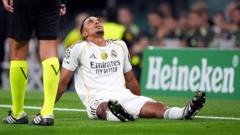“Injuries can change the course of a season.” This statement rings particularly true as Trent Alexander-Arnold faces a potential six-week absence due to a hamstring injury. The incident occurred during a high-stakes Champions League match where Real Madrid triumphed over Marseille. As one of the top players in the league, his absence could have significant implications not only for his team but also for the broader competitive landscape of European football. With the Champions League knockout stages approaching, the timing of this injury raises questions about how it will affect both Alexander-Arnold’s performance and his team’s chances of advancing.
The stakes are high for Real Madrid, a club that thrives on its rich history in the Champions League. Alexander-Arnold’s role as a vital playmaker and defender cannot be overstated. His ability to contribute both offensively and defensively makes him an integral part of the team’s strategy. As fans and analysts speculate on the impact of his absence, the question remains: how will Real Madrid adjust its tactics in light of this setback? The next few weeks will be critical for the team as they navigate through crucial matches without one of their key players.
Impact of Alexander-arnold’s Absence on Team Dynamics
Trent Alexander-Arnold’s injury comes at a pivotal moment for Real Madrid. His unique skill set allows him to excel in both defensive duties and offensive contributions. As a right-back, he is known for his exceptional crossing ability and vision, which have been instrumental in creating goal-scoring opportunities. Without him on the field, the team will need to adapt quickly to maintain its competitive edge. The coaching staff faces the challenge of reconfiguring the lineup, potentially shifting players into unfamiliar roles to compensate for his absence.
Moreover, the psychological impact of losing a star player like Alexander-Arnold cannot be overlooked. His presence on the pitch often boosts team morale, and his absence may create a void that affects the overall performance of the squad. Teammates may feel increased pressure to step up, which can lead to both positive and negative outcomes. The dynamics of the locker room will likely shift, as players must rally together to fill the gap left by their injured comrade.
In terms of tactical adjustments, Real Madrid may opt for a more conservative approach in the short term. They could focus on strengthening their defense to mitigate the loss of Alexander-Arnold’s offensive contributions. Alternatively, they might choose to promote a younger player from the reserves, which could provide an opportunity for emerging talent to shine in a high-pressure environment. Regardless of the strategy, the upcoming weeks will be crucial for determining how effectively the team can adapt to this unexpected challenge.
Analyzing the Injury: Causes and Recovery Timeline
The hamstring injury sustained by Alexander-Arnold is not uncommon in professional football, particularly given the physical demands placed on players during intensive matches. Hamstring injuries often arise from a combination of factors, including fatigue, inadequate warm-up, or sudden bursts of speed. In this case, the injury occurred during a critical moment in the match against Marseille, underscoring the unpredictable nature of sports injuries.
Recovery from a hamstring injury typically involves a multi-faceted approach, including rest, physical therapy, and gradual reintegration into training. Experts suggest that a six-week timeline for recovery is realistic, provided there are no complications. During this period, Alexander-Arnold will likely undergo rehabilitation exercises aimed at strengthening the affected muscle group and preventing future injuries. The medical staff will play a crucial role in monitoring his progress, ensuring that he returns to peak physical condition before rejoining his teammates.
Additionally, this injury raises questions about player management and the importance of maintaining fitness levels throughout the season. Clubs must balance the demands of competitive play with the need for player well-being. The increasing frequency of injuries in football highlights the need for teams to invest in preventive measures, such as tailored training programs and recovery protocols, to minimize the risk of injury among their players.
Future Implications for Real Madrid and Alexander-arnold
The long-term implications of Alexander-Arnold’s injury extend beyond the immediate impact on team performance. For Real Madrid, navigating the Champions League without one of their star players could influence their strategy in both domestic and international competitions. The team’s depth will be tested, and the success of their adjustments could set the tone for the remainder of the season. A strong performance during this challenging period could bolster team cohesion and provide valuable experience for younger players.
For Alexander-Arnold, this injury represents a significant setback in his career. As a player known for his resilience and determination, he will undoubtedly be eager to return to the pitch. However, rushing back too soon could lead to further complications and prolong his absence. The focus will need to be on a complete recovery to ensure he can perform at his best upon his return.
Ultimately, this injury serves as a reminder of the unpredictable nature of sports. While the immediate focus is on recovery and team adjustments, the broader implications for player health and team dynamics will continue to be a topic of discussion among fans and analysts alike. As Real Madrid navigates this challenging period, all eyes will be on how they adapt and the resilience of their star player as he works toward a comeback.


